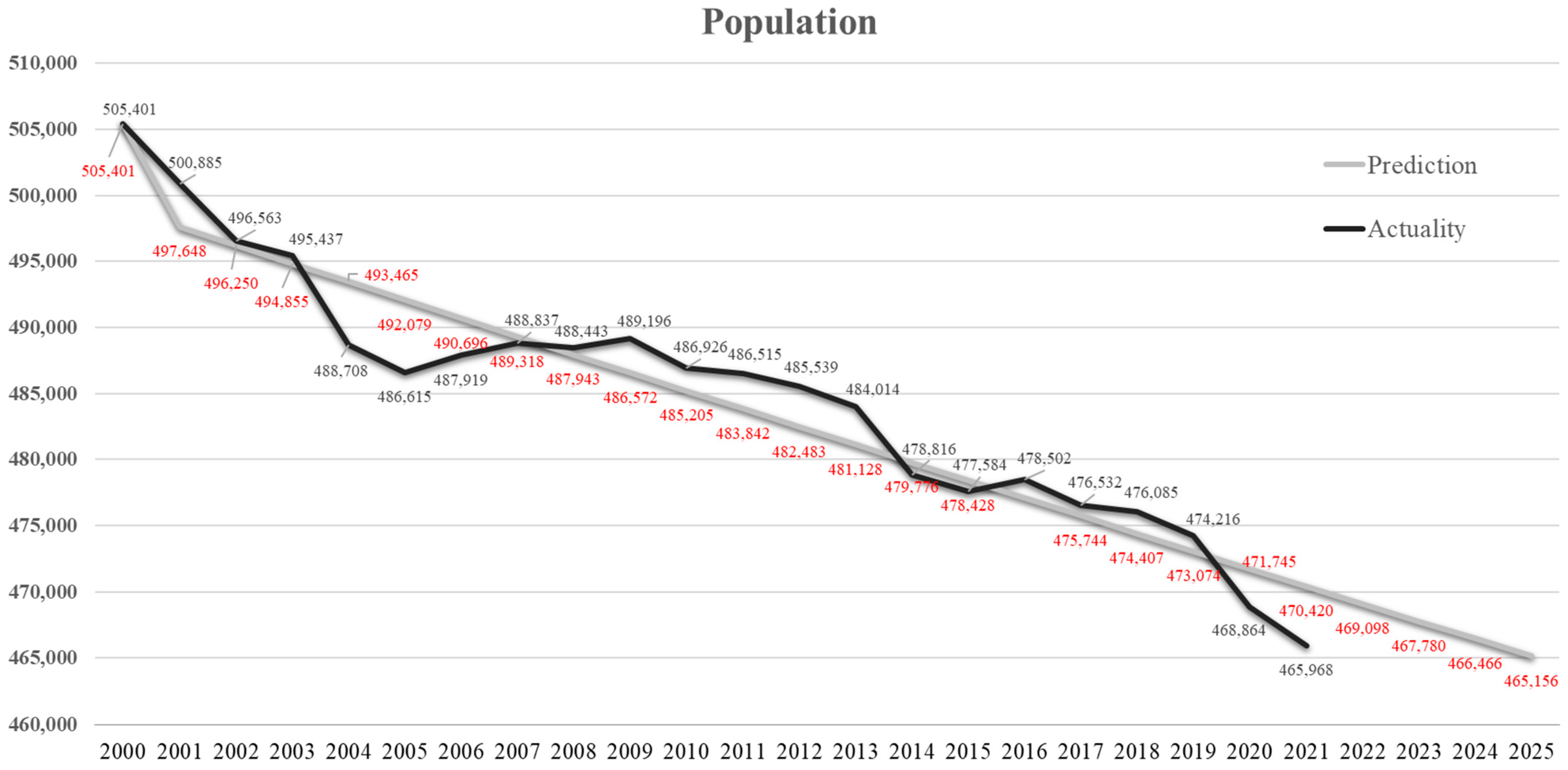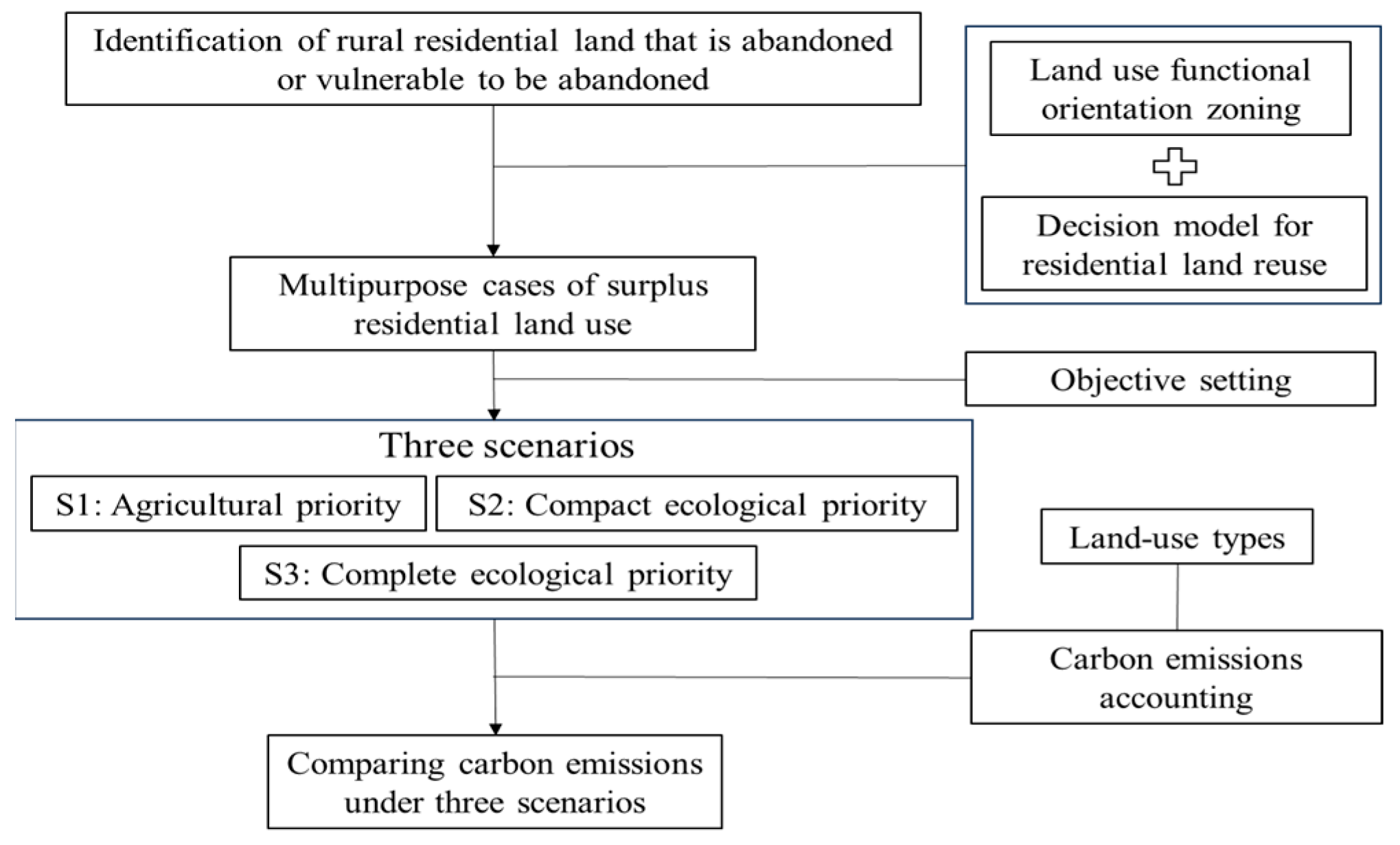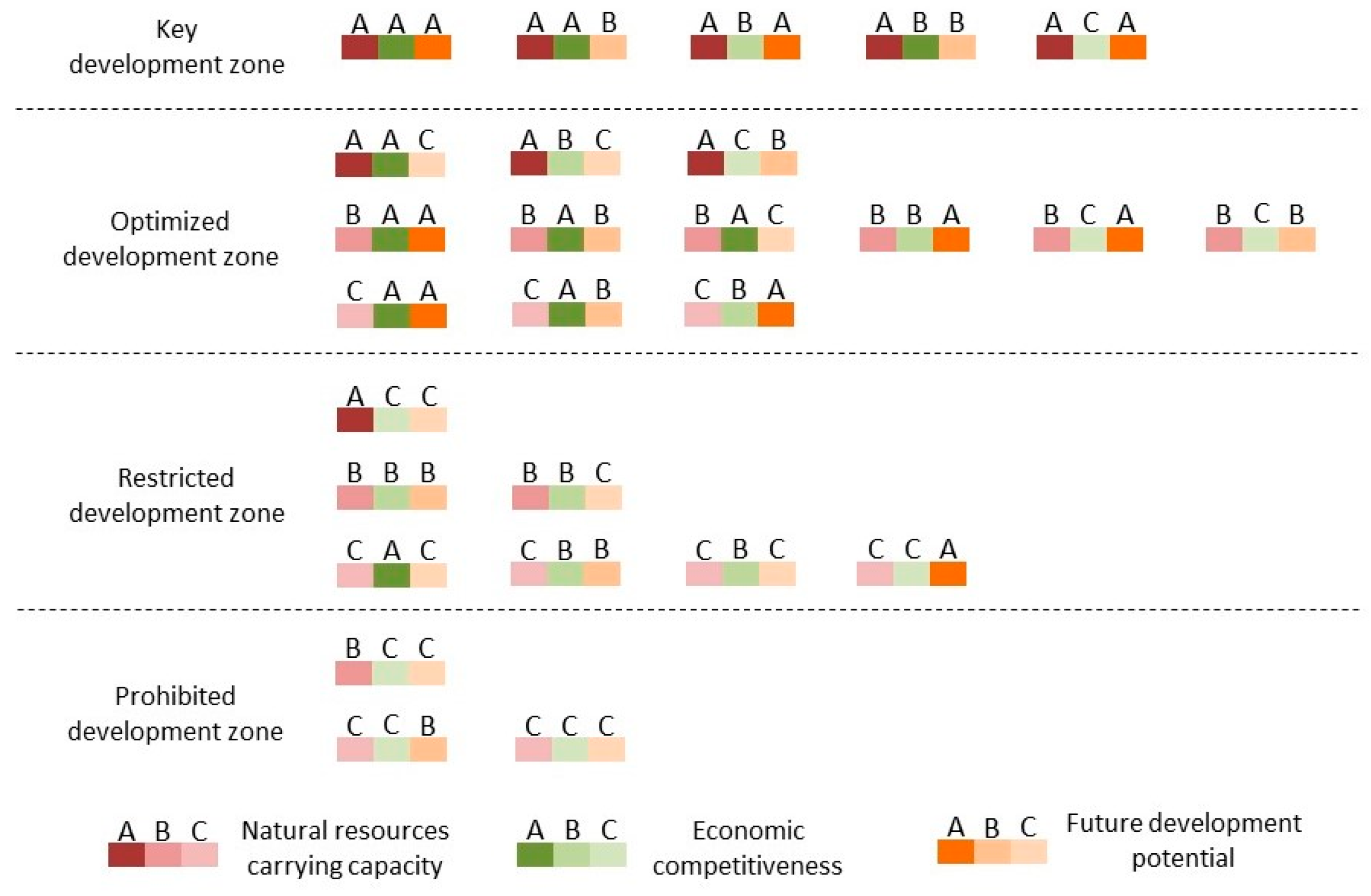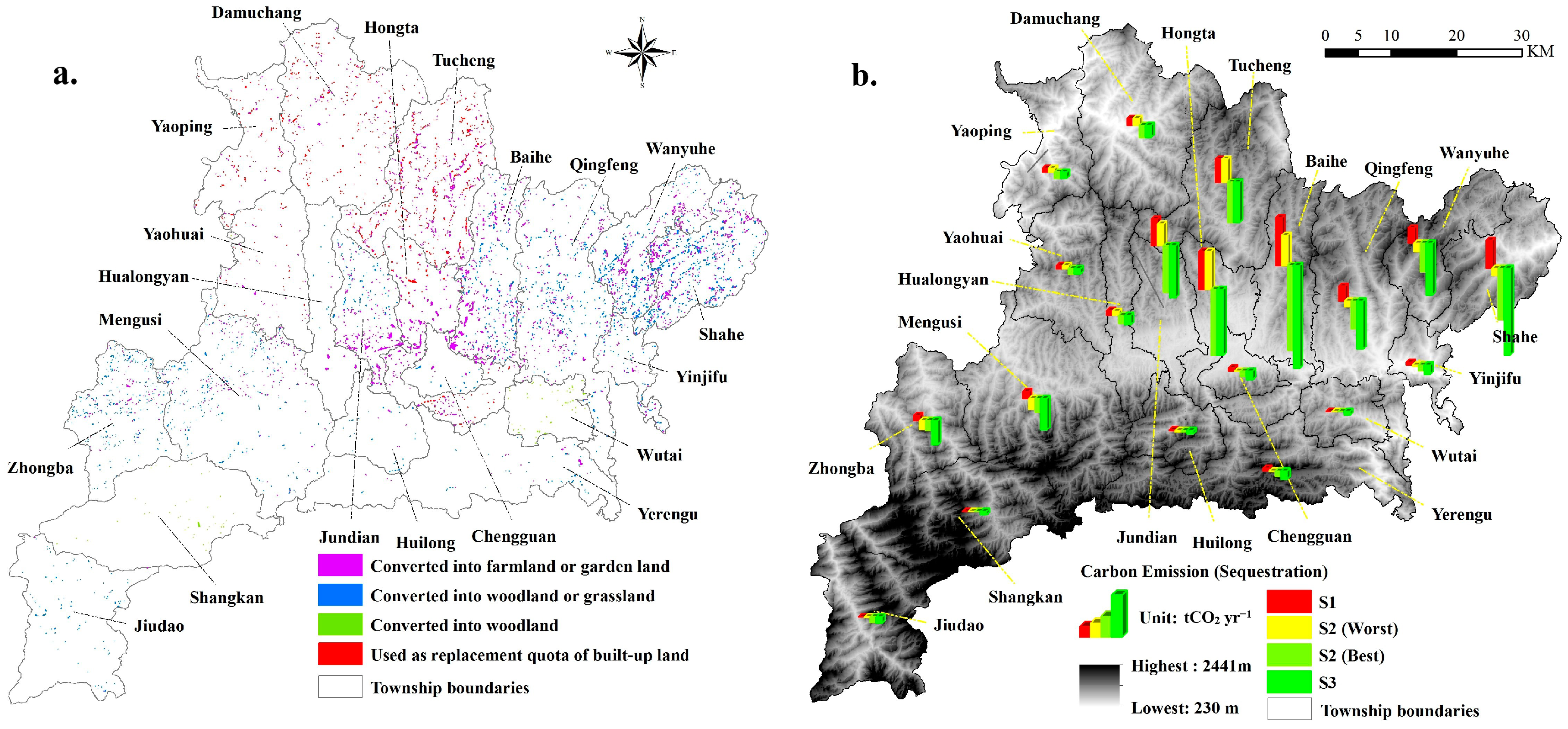Scenario Analysis of Carbon Emission Changes Resulting from a Rural Residential Land Decrement Strategy: A Case Study in China
Abstract
1. Introduction
2. Materials and Methods
2.1. Study Area and Context
2.2. Analytic Framework
2.3. Methods
2.3.1. Land-Use Function Orientated Zoning
- Indicator selection:
- Indicator weight calculation:
- Multi-dimensional grading and classification model for zoning:
2.3.2. Decision Model for Repurposing Cases of RRL
2.3.3. Prediction Methodologies
2.3.4. Carbon Emission Assessment Model Based on Land Use
2.4. Data Sources
3. Results
3.1. Land-Use Function Orientated Zone
3.2. Criteria of RRLD
3.3. RRL for Stable Use and Reserve
3.4. Multiple Scenarios of RRLD and Its Carbon Emission Response
4. Discussion
4.1. Policy Implications
4.2. Limitations and Future Directions
5. Conclusions
Author Contributions
Funding
Data Availability Statement
Acknowledgments
Conflicts of Interest
Appendix A

Appendix B

References
- Intergovernmental Panel on Climate Change (IPCC). Climate Change 2007: The Physical Science Basis; Contribution of working group I to the fourth assessment report of the Intergovernmental Panel on Climate Change; Cambridge University Press: Cambridge, UK, 2007. [Google Scholar]
- Sleeter, B.M.; Sohl, T.L.; Bouchard, M.A.; Reker, R.R.; Soulard, C.E.; Acevedo, W.; Griffith, G.E.; Sleeter, R.R.; Auch, R.F.; Sayler, K.L.; et al. Scenarios of land use and land cover change in the conterminous United States: Utilizing the special report on emission scenarios at ecoregional scales. Glob. Environ. Change 2012, 22, 896–914. [Google Scholar] [CrossRef]
- Arneth, A. Historical carbon dioxide emissions caused by land-use changes are possibly larger than assumed. Nat. Geosci. 2017, 10, 79–84. [Google Scholar] [CrossRef]
- Chang, X.; Xing, Y.; Wang, J.; Yang, H.; Gong, W. Effects of land use and cover change (LUCC) on terrestrial carbon stocks in China between 2000 and 2018. Resour. Conservat. Recycl. 2022, 182, 106333. [Google Scholar] [CrossRef]
- Gray, C.L. Environment, land, and rural out-migration in the southern Ecuadorian Andes. World Dev. 2009, 37, 457–468. [Google Scholar] [CrossRef]
- Xia, C.; Zhang, J.; Zhao, J.; Xue, F.; Li, Q.; Fang, K.; Shao, Z.; Zhang, J.; Li, S.; Zhou, J. Exploring potential of urban land-use management on carbon emissions— A case of Hangzhou, China. Ecol. Indic. 2023, 146, 109902. [Google Scholar] [CrossRef]
- Gasser, T.; Crepin, L.; Quilcaille, Y.; Houghton, R.A.; Ciais, P.; Obersteiner, M. Historical CO2 emissions from land use and land cover change and their uncertainty. Biogeosciences 2020, 17, 4075–4101. [Google Scholar] [CrossRef]
- Levy, P.E.; Friend, A.D.; White, A.; Cannell, M.G.R. The influence of land use change on global-scale fluxes of carbon from terrestrial ecosystems. Clim. Chang. 2004, 67, 185–209. [Google Scholar] [CrossRef]
- Li, L.; Huang, X.; Yang, H.; Chuai, X.; Zhang, M.; Zhong, T.; Chen, Z.; Chen, Y.; Wang, X.; Thompson, J.R. Carbon emissions from land-use change and management in China between 1990 and 2010. Sci. Adv. 2016, 2, e1601063. [Google Scholar] [CrossRef]
- Tang, X.; Zhao, X.; Bai, Y.; Zhou, G. Carbon pools in China’s terrestrial ecosystems: New estimates based on an intensive field survey. Proc. Natl. Acad. Sci. USA 2018, 115, 4021–4026. [Google Scholar] [CrossRef]
- Yuan, Y.; Chuai, X.; Xiang, C.; Gao, R. Carbon emissions from land use in Jiangsu, China, and analysis of the regional interactions. Environ. Sci. Pollut. Res. 2022, 29, 44523–44539. [Google Scholar] [CrossRef]
- Fan, L.; Cai, T.; Wen, Q.; Han, J.; Wang, S.; Wang, J.; Yin, C. Scenario simulation of land use change and carbon storage response in Henan Province, China: 1990–2050. Ecol. Indic. 2023, 154, 110660. [Google Scholar] [CrossRef]
- Shu, H.; Xiong, P. Reallocation planning of urban industrial land for structure optimization and emission reduction: A practical analysis of urban agglomeration in China’s Yangtze River Delta. Land Use Pol. 2019, 81, 604–623. [Google Scholar] [CrossRef]
- Gao, J.; Wang, L. Embedding spatiotemporal changes in carbon storage into urban agglomeration ecosystem management—A case study of the Yangtze River Delta, China. J. Clean. Prod. 2019, 237, 117764. [Google Scholar] [CrossRef]
- Zhang, X.; Brandt, M.; Tong, X.; Ciais, P.; Yue, Y.; Xiao, X.; Zhang, W.; Wang, K.; Fensholt, R. A large but transient carbon sink from urbanization and rural depopulation in China. Nat. Sustain. 2022, 5, 321–328. [Google Scholar] [CrossRef]
- Wu, Q.; Wang, X.; Chen, S.; Wang, L.; Jiang, J. Land surface greening and CO2 fertilization more than offset the gross carbon sequestration decline caused by land cover change and the enhanced vapour pressure deficit in Europe. Remote Sens. 2023, 15, 1372. [Google Scholar] [CrossRef]
- de Chazal, J.; Rounsevell, M.D.A. Land-use and climate change within assessments of biodiversity change: A review. Glob. Environ. Chang. 2009, 19, 306–315. [Google Scholar] [CrossRef]
- Li, B.V.; Jenkins, C.N.; Xu, W. Strategic protection of landslide vulnerable mountains for biodiversity conservation under land-cover and climate change impacts. Proc. Natl. Acad. Sci. USA 2022, 119, e2113416118. [Google Scholar] [CrossRef]
- Zhou, L.; Dickinson, R.E.; Tian, Y.; Fang, J.; Li, Q.; Kaufmann, R.K.; Tucker, C.J.; Myneni, R.B. Evidence for a significant urbanization effect on climate in China. Proc. Natl. Acad. Sci. USA 2004, 101, 9540–9544. [Google Scholar] [CrossRef]
- Ye, X.; Chuai, X. Have rural settlement changes harmed ecosystem carbon in China? Appl. Geogr. 2023, 153, 102917. [Google Scholar] [CrossRef]
- Gao, X.; Xu, A.; Liu, L.; Deng, O.; Zeng, M.; Ling, J.; Wei, Y. Understanding rural housing abandonment in China’s rapid urbanization. Habitat Int. 2017, 67, 13–21. [Google Scholar] [CrossRef]
- Ravallion, M.; Jalan, J. China’s lagging poor areas. Am. Econ. Rev. 1999, 89, 301–305. [Google Scholar] [CrossRef]
- Siciliano, G. Urbanization strategies, rural development and land use changes in China: A multiple-level integrated assessment. Land Use Pol. 2012, 29, 165–178. [Google Scholar] [CrossRef]
- Long, H.; Tu, S.; Ge, D.; Li, T.; Liu, Y. The allocation and management of critical resources in rural China under restructuring: Problems and prospects. J. Rural Stud. 2016, 47, 392–412. [Google Scholar] [CrossRef]
- Weissteiner, C.J.; Boschetti, M.; Böttcher, K.; Carrara, P.; Bordogna, G.; Brivio, P.A. Spatial explicit assessment of rural land abandonment in the Mediterranean area. Glob. Planet. Chang. 2011, 79, 20–36. [Google Scholar] [CrossRef]
- Yao, G.; Xie, H. Rural spatial restructuring in ecologically fragile mountainous areas of southern China: A case study of Changgang Town, Jiangxi Province. J. Rural Stud. 2016, 47, 435–446. [Google Scholar] [CrossRef]
- Lambin, E.F.; Meyfroidt, P. Land use transition: Socio-ecological feedback versus socio-economic change. Land Use Pol. 2010, 27, 108–118. [Google Scholar] [CrossRef]
- Long, H.; Li, Y.; Liu, Y.; Woods, M.; Zou, J. Accelerated restructuring in rural China fueled by’ increasing vs. decreasing balance’ land-use policy for dealing with hollowed villages. Land Use Pol. 2012, 29, 11–22. [Google Scholar] [CrossRef]
- Qu, Y.; Jiang, G.; Li, Z.; Tian, Y.; Wei, S. Understanding rural land use transition and regional consolidation implications in China. Land Use Pol. 2019, 82, 742–753. [Google Scholar] [CrossRef]
- Vidal-Legaz, B.; Martínez-Fernández, J.; Picón, A.S.; Pugnaire, F.I. Trade-offs between maintenance of ecosystem services and socio-economic development in rural mountainous communities in southern Spain: A dynamic simulation approach. J. Environ. Manag. 2013, 131, 280–297. [Google Scholar] [CrossRef]
- An Overview of Fang County. Available online: http://www.fangxian.gov.cn/fyfx/fxgk/qhrk/202308/t20230816_4294641.shtml (accessed on 28 August 2023). (In Chinese)
- Land Use Planning of Fang County (2010–2020). Available online: http://www.fangxian.gov.cn/xxgk/fdzdgknr/ghxx/201707/t20170726_1153629.shtml (accessed on 28 August 2023). (In Chinese)
- Zhang, J.; Li, S.; Lin, N.; Lin, Y.; Yuan, S.; Zhang, L.; Zhu, J.; Wang, K.; Gan, M.; Zhu, C. Spatial identification and trade-off analysis of land use functions improve spatial zoning management in rapid urbanized areas, China. Land Use Pol. 2022, 116, 106058. [Google Scholar] [CrossRef]
- Liu, Y. Introduction to land use and rural sustainability in China. Land Use Pol. 2018, 74, 1–4. [Google Scholar] [CrossRef]
- Long, H.; Qu, Y. Land use transitions and land management: A mutual feedback perspective. Land Use Pol. 2018, 74, 111–120. [Google Scholar] [CrossRef]
- Zhou, J.; Cao, X. What is the policy improvement of China’s land consolidation? Evidence from completed land consolidation projects in Shaanxi Province. Land Use Pol. 2020, 99, 104847. [Google Scholar] [CrossRef]
- Xu, D.; Guo, S.; Xie, F.; Liu, S.; Cao, S. The impact of rural laborer migration and household structure on household land use arrangements in mountainous areas of Sichuan Province, China. Habitat Int. 2017, 70, 72–80. [Google Scholar] [CrossRef]
- Fan, J.; Wang, Y.; Wang, C.; Chen, T.; Jin, F.; Zhang, W.; Li, L.; Xu, Y.; Dai, E.; Tao, A.; et al. Reshaping the sustainable geographical pattern: A major function zoning model and its applications in China. Earth Future 2019, 7, 25–42. [Google Scholar] [CrossRef]
- Fang, C.; Liu, X. Comprehensive measurement for carrying capacity of resources and environment of city clusters in Central China. Chin. Geogr. Sci. 2010, 20, 281–288. [Google Scholar] [CrossRef]
- Shen, L.; Cheng, G.; Du, X.; Meng, C.; Ren, Y.; Wang, J. Can urban agglomeration bring “1 + 1 > 2Effect”? A perspective of land resource carrying capacity. Land Use Pol. 2022, 117, 106094. [Google Scholar] [CrossRef]
- Zhang, F.; Wang, Y.; Ma, X.; Wang, Y.; Yang, G.; Zhu, L. Evaluation of resources and environmental carrying capacity of 36 large cities in China based on a support-pressure coupling mechanism. Sci. Total Environ. 2019, 688, 838–854. [Google Scholar] [CrossRef]
- Satty, T.L. A scaling method for priorities in hierarchical structures. J. Math. Psychol. 1977, 15, 234–281. [Google Scholar] [CrossRef]
- Hwang, C.L.; Yoon, K.P. Multiple Attribute Decision Making: Methods and Applications; Springer: New York, NY, USA, 1981. [Google Scholar]
- Tian, G.; Qiao, Z.; Zhang, Y. The investigation of relationship between rural settlement density, size, spatial distribution and its geophysical parameters of China using Landsat TM images. Ecol. Model. 2012, 231, 25–36. [Google Scholar] [CrossRef]
- Tan, G. The structure method and application of background value in grey system GM(1,1) Model (I). J. Theor. Pract. Syst. Eng. 2000, 20, 98–103. [Google Scholar]
- Chen, L.; Sun, Y.; Saeed, S. Monitoring and predicting land use and land cover changes using remote sensing and GIS techniques—A case study of a hilly area, Jiangle, China. PloS ONE 2018, 13, e0200493. [Google Scholar]
- Xu, F.; Ho, H.C.; Chi, G.; Wang, Z. Abandoned rural residential land: Using machine learning techniques to identify rural residential land vulnerable to be abandoned in mountainous areas. Habitat Int. 2019, 84, 43–56. [Google Scholar] [CrossRef]
- Zhu, E.; Deng, J.; Zhou, M.; Gan, M.; Jiang, R.; Wang, K.; Shahtahmassebi, A. Carbon emissions induced by land-use and land-cover change from 1970 to 2010 in Zhejiang, China. Sci. Total Environ. 2019, 646, 930–939. [Google Scholar] [CrossRef] [PubMed]
- Sun, X. Effects of carbon emission by land use patterns in Hefei’s economic circle of Anhui Province. J. Nat. Resour. 2012, 27, 394–401. (In Chinese) [Google Scholar]
- Zhao, R.; Huang, X.; Zhong, T.; Chuai, X. Carbon effect evaluation and low-carbon optimization of regional land use. Trans. Chin. Soc. Agric. Eng. 2013, 29, 220–229. (In Chinese) [Google Scholar]
- Fang, J.; Guo, Z.; Piao, S. Terrestrial vegetation carbon sinks in China, 1981 to 2000. Sci. China Ser. D 2007, 50, 1341–1350. (In Chinese) [Google Scholar] [CrossRef]
- Deng, J. Grey Forecasting and Decision; Huazhong University of Science and Technology Press: Wuhan, China, 1986. [Google Scholar]
- Wu, S.; Hu, S.; Frazier, A.E.; Hu, Z. China’s urban and rural residential carbon emissions: Past and future scenarios. Resour. Conservat. Recycl. 2023, 190, 106802. [Google Scholar] [CrossRef]
- Smith, M.D.; Giraud, D. Traditional land-use planning regulation and agricultural land conservation: A case study from the USA. Plan. Pract. Res. 2006, 21, 407–421. [Google Scholar] [CrossRef]
- Ma, S.; Mu, R. Forced off the farm? Farmers’ labor allocation response to land requisition in China. World Dev. 2020, 132, 104980. [Google Scholar] [CrossRef]
- Barbier, E.B. Is green rural transformation possible in developing countries? World Dev. 2020, 131, 104955. [Google Scholar] [CrossRef]
- Kong, X.; Liu, Y.; Jiang, P.; Tian, Y.; Zou, Y. A novel framework for rural homestead land transfer under collective ownership in China. Land Use Pol. 2018, 78, 138–146. [Google Scholar] [CrossRef]






| Criterion Layer | Indicator Layer (Unit) | AHP Weight | Entropy Weight | Weighted Weight |
|---|---|---|---|---|
| Natural resources carrying capacity | Ecological service value per capita (CNY/person) | 0.1496 | 0.0638 | 0.1153 |
| Proportion of green space (%) | 0.0346 | 0.0051 | 0.0228 | |
| Carrying capacity of agricultural land resources (–) | 0.2881 | 0.0239 | 0.1824 | |
| Proportion of water area (%) | 0.0666 | 0.0555 | 0.0622 | |
| Proportion of urban construction land (%) | 0.0083 | 0.0381 | 0.0202 | |
| Economic competitiveness | Industrial output value of land (10,000 CNY/km2) | 0.0467 | 0.1480 | 0.0872 |
| Public finance expenditure of land (10,000 CNY/km2) | 0.0392 | 0.1305 | 0.0757 | |
| Retail sales of consumer goods per capita (CNY/person) | 0.0241 | 0.0750 | 0.0445 | |
| Population density (people/km2) | 0.0218 | 0.0572 | 0.0360 | |
| Proportion of employed population (%) | 0.0057 | 0.0077 | 0.0065 | |
| Density of road network (km/km2) | 0.0141 | 0.0432 | 0.0257 | |
| Proportion of people with minimum living security (%) | 0.0039 | 0.0010 | 0.0027 | |
| Future development potential | Exploitable land resources per capita (m2/person) | 0.0908 | 0.0549 | 0.0765 |
| Degree of topographic relief (–) | 0.0430 | 0.0049 | 0.0278 | |
| Degree of location advantage (m) | 0.1195 | 0.0073 | 0.0746 | |
| Total tax paid by enterprises (10,000 CNY) | 0.0268 | 0.1438 | 0.0736 | |
| Total revenue of public finance (10,000 CNY) | 0.0172 | 0.1401 | 0.0664 |
| Criterion Layer | Class A | Class B | Class C |
|---|---|---|---|
| Natural resources carrying capacity | >0.28 | 0.21~0.28 | <0.21 |
| Economic competitiveness | >0.07 | 0.05~0.07 | <0.05 |
| Future development potential | >0.40 | 0.25~0.40 | <0.25 |
| Land-Use Type | Farmland | Garden Land | Woodland | Grassland |
|---|---|---|---|---|
| Coefficient | 0.0422 | −0.0730 | −0.0578 | −0.0021 |
| Source | Sun [49] | Zhao et al. [50] | Fang et al. [51] | Fang et al. [51] |
| Zoning Groups | Slope (°) | Repurposing Options | Rules |
|---|---|---|---|
| Key development zone | ≤15 | Farmland or garden land | None |
| >15 | Built-up land (for displacement) | The residential land reuse is determined by the type of land occupied by built-up land | |
| Optimized development zone | ≤15 | Farmland or garden land | None |
| >15 | Woodland or grassland | None | |
| Restricted development zone | ≤15 | Farmland or garden land | None |
| >15 | Woodland or grassland | ||
| Prohibited development zone | All | Woodland | All residential land parcels are forcibly converted to woodland |
| Land-Use Type | S1 | S2 | S3 |
|---|---|---|---|
| Farmland | 1155.34 | up to 1155.34 | - |
| Garden land | - | 0~1155.34-Qfarmland | 1155.34 |
| Woodland | 24.58 | 24.58~582.51 | 582.51 |
| Grassland | 557.94 | 0~557.94-Qwoodland | - |
| Built-up land (for displacement) | 274.38 | 274.38 | 274.38 |
Disclaimer/Publisher’s Note: The statements, opinions and data contained in all publications are solely those of the individual author(s) and contributor(s) and not of MDPI and/or the editor(s). MDPI and/or the editor(s) disclaim responsibility for any injury to people or property resulting from any ideas, methods, instructions or products referred to in the content. |
© 2024 by the authors. Licensee MDPI, Basel, Switzerland. This article is an open access article distributed under the terms and conditions of the Creative Commons Attribution (CC BY) license (https://creativecommons.org/licenses/by/4.0/).
Share and Cite
Xu, F.; Chi, G.; Wang, H. Scenario Analysis of Carbon Emission Changes Resulting from a Rural Residential Land Decrement Strategy: A Case Study in China. Land 2024, 13, 51. https://doi.org/10.3390/land13010051
Xu F, Chi G, Wang H. Scenario Analysis of Carbon Emission Changes Resulting from a Rural Residential Land Decrement Strategy: A Case Study in China. Land. 2024; 13(1):51. https://doi.org/10.3390/land13010051
Chicago/Turabian StyleXu, Feng, Guangqing Chi, and Huan Wang. 2024. "Scenario Analysis of Carbon Emission Changes Resulting from a Rural Residential Land Decrement Strategy: A Case Study in China" Land 13, no. 1: 51. https://doi.org/10.3390/land13010051
APA StyleXu, F., Chi, G., & Wang, H. (2024). Scenario Analysis of Carbon Emission Changes Resulting from a Rural Residential Land Decrement Strategy: A Case Study in China. Land, 13(1), 51. https://doi.org/10.3390/land13010051








